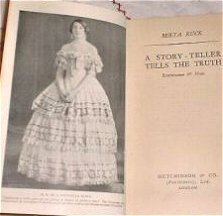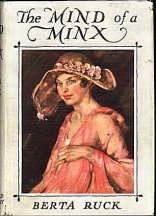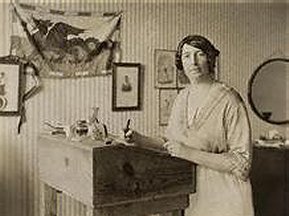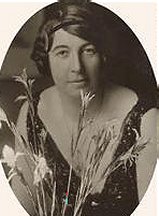Cyrano de Bergerac. Translated by Helen B.
Dole. NY: T.Y. Crowell & Company, 1899.
Flyleaf inscription: “E.R. Burroughs, Chicago,
January 17th, 1903.”
Synopsis
and Download
Cyrano Chicago 1903: Ed's sig Pub 1899
Cyrano
de Bergerac by Edmond Rostand on Project Gutenberg
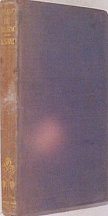
|
This book has a dedication take from the poem
Envoi by Don Marquis
A little while the grief
and laughter,
The myrtle and the rose,
A little while... and what
comes after
No man knows.
Still mounts the dream on
shining pinion . . .
Still broods the dull distrust
,
Which shall have ultimate
dominion,
Dream, or dust?
|
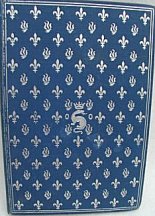 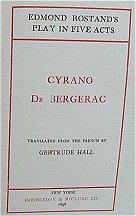 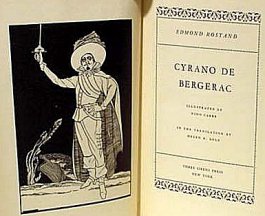 First produced in 1897, CYRANO DE BERGERAC takes place in
the 17th century. Rostand's classic drama presents a complex hero--one
who is in the tradition of both the swashbuckling adventurer and
the sensitive, more modern thinker and self-questioner. Cursed with ugliness
but blessed with sublime wit and poetic ability, the gallant Cyrano loves
his cousin Roxanne, who loves the handsome but inarticulate Christian.
By means of his own gifts with language, Cyrano selflessly helps Christian
woo Roxane--and only when it's too late does she realize that the passion
and eloquence she has prized belong not to Christian but to Cyrano, and
that it is her grotesque cousin she has loved all along.
First produced in 1897, CYRANO DE BERGERAC takes place in
the 17th century. Rostand's classic drama presents a complex hero--one
who is in the tradition of both the swashbuckling adventurer and
the sensitive, more modern thinker and self-questioner. Cursed with ugliness
but blessed with sublime wit and poetic ability, the gallant Cyrano loves
his cousin Roxanne, who loves the handsome but inarticulate Christian.
By means of his own gifts with language, Cyrano selflessly helps Christian
woo Roxane--and only when it's too late does she realize that the passion
and eloquence she has prized belong not to Christian but to Cyrano, and
that it is her grotesque cousin she has loved all along.
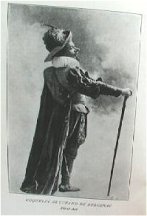 Savien
Cyrano de Bergerac (1619-1655) French soldier, satirist,
and dramatist, whose life has been the basis of many romantic but unhistorical
legends. The best-known of them is Edmond Rostand's verse drama Cyrano
de Bergerac (1897). Bergerac's major works were two posthumously published
accounts of fantastic voyages, VOYAGE DANS LA LUNE (1657) and L'HISTOIRE
DES ÉTATS ET EMPIRES DU SOLEIL (1662). According to Arhur C. Clarke,
Cyrano must be credited both for first applying the rocket to space travel
and, for inventing the ramjet.The real Cyrano de Bergerac had, in real
life, very little in common with the hero of the Rostand play. He was born
in Paris, and educated by a priest in the village of Bergerac. Later he
was sent to the Collège de Beauvais. After acquiring fame as a dueller
and Bohemian, he enlisted in the army at the age of 20. However, he was
an individualist and had problems adjusting to discipline - Cyrano was
an opponent of the war and death penalty. His humanitarian way of thinking
was acknowledged by his contemporaries and the next generations. Le Doyen's
portrait of him, made after Heince, shows a sceptically smiling man, with
thin moustaches and a large nose. Cyrano was severely wounded twice, once
at a fight with a Gascon Guard, and the second time at the siege of Arras
in 1640. There he was hit in the neck with a sword and he never fully recovered
from the wound. In the following year he gave up his military career and
started to study under the philosopher and mathematician Pierre Gassendi.
Influenced by Gassendi's theories and libertine philosophy, he wrote stories
of imaginary journeys to the Moon and Sun, and satirized views, which saw
humanity and the Earth as the center of creation. He also mocked Descartes'
idea that animals are soulless machines. In his trip to the Moon Cyrano
took off from the Earth in an apparatus festooned with firecrackers. There
he is classified as a bird because he has two legs. In the second journey
he is tried for the crimes of humanity by a court of birds. Cyrano defends
himself saying that he is not a human being but an ape. In the 1650s Cyrano
de Bergerac published two plays, LA MORT D'AGRIPPINE (1654), which was
suspected of blasphemy, and LE PÉDANT JOUÉ (1654), from which
Molière borrowed heavily for his play The Cheats of Chapin.
Cyrano de Bergerac died in Paris on July 28, 1655. The cause of Cyrano's
death was banal: a piece of plank dropped on his head. Only parts of his
major work, L'AUTRE MONDE; OU, LES ÉTATS ET EMPIRES DE LA LUNE (Other
Worlds: The Comical History of the States and The Empires of the Moon and
the Sun, were published in posthumous versions. Other Worlds continued
the Rabelaisian tradition of satire and was based on Lucian's A True Story.
Henri le Bret, the author's friend, censored its heretical elements. In
1676 Cyrano's collected works appeared, which included a biting poem of
Mazarin (1602-61), the famous French cardinal and statesman. Rostand's
Cyrano de Bergerac describes the adventures of the 17th century nobleman,
famous for his large nose and swordsmanship. "'Tis well known, a big nose
is indicative / Of a soul affable, and kind, and courteous, / Liberal,
brave, just like myself, and such / As you can never dare to dream yourself..."
Cyrano desperately loves the beautiful Roxane, but agrees to help his rival,
Christian, win her heart. The historians have pointed out that Rostand's
portrayal of the hero was not truthful - Cyrano was a serious writer of
philosophical romances and a virile lover. It is assumed, that the third
volume in Cyrano Bergerac's series HISTOIRE COMIQUE, The History of the
Stars, is lost or has been destroyed. Other parts were Comical History
of the States and Empires of the Moon (1656) and Comical History of the
States and Empires of the Sun (1661). The books, together known as L'autre
monde, belong in the genre 'fantastic voyages', of which the oldest examples
are the Sumerian Epic of Gilgamesh, from the third millenium BC, and Homer's
Odyssey, from the first. Johannes Kepler's Somnium (1643), Francis Bacon's
New Atlantis (1627), and Tommasso Campanella's City of the Sun were written
in the 17th century. Cyrano's imaginary visits to the moon and sun satirized
the people and politics of his own day. Cyrano is escorted on the Moon
by the Demon of Socrates, who says: "If there is something you men cannot
understand, you either imagine that it is spiritual or that it does not
exists. Both conclusions are quite false. The proof of this is the fact
that there are perhaps a million things in the universe which you would
need a million quite different organs to know. Myself, for example, I know
from my senses what attracts the lodestone to the pole, how the tides pull
the sea, what becomes of an animal after its death." (from Trillion Years
Spree by Brian Aldiss & David Wingrove, 2001) In the second book
he lands on the Sun, managing to invent an explanation why the heat doesn't
burn. He meets Campanella, author of Civitas Solis, to whom a woman tells
that her husband has killed her child twice. He has not fulfilled his conjugal
duty, because by refusing to make the child "come into existence, he caused
him not to be, which was the first murder, but subsequently he caused him
never to be able to be, which was the second. A Common murderer knows that
the man whose days he cuts short is no more, but none of them could cause
a man never to have been." Bergerac's works influenced several later writers,
among them Jonathan Swift and Voltaire, whose fantastical Micromégas:
Histoire philosophique (1752) satirized our world from the viewpoint of
giant visitors from space. Savien
Cyrano de Bergerac (1619-1655) French soldier, satirist,
and dramatist, whose life has been the basis of many romantic but unhistorical
legends. The best-known of them is Edmond Rostand's verse drama Cyrano
de Bergerac (1897). Bergerac's major works were two posthumously published
accounts of fantastic voyages, VOYAGE DANS LA LUNE (1657) and L'HISTOIRE
DES ÉTATS ET EMPIRES DU SOLEIL (1662). According to Arhur C. Clarke,
Cyrano must be credited both for first applying the rocket to space travel
and, for inventing the ramjet.The real Cyrano de Bergerac had, in real
life, very little in common with the hero of the Rostand play. He was born
in Paris, and educated by a priest in the village of Bergerac. Later he
was sent to the Collège de Beauvais. After acquiring fame as a dueller
and Bohemian, he enlisted in the army at the age of 20. However, he was
an individualist and had problems adjusting to discipline - Cyrano was
an opponent of the war and death penalty. His humanitarian way of thinking
was acknowledged by his contemporaries and the next generations. Le Doyen's
portrait of him, made after Heince, shows a sceptically smiling man, with
thin moustaches and a large nose. Cyrano was severely wounded twice, once
at a fight with a Gascon Guard, and the second time at the siege of Arras
in 1640. There he was hit in the neck with a sword and he never fully recovered
from the wound. In the following year he gave up his military career and
started to study under the philosopher and mathematician Pierre Gassendi.
Influenced by Gassendi's theories and libertine philosophy, he wrote stories
of imaginary journeys to the Moon and Sun, and satirized views, which saw
humanity and the Earth as the center of creation. He also mocked Descartes'
idea that animals are soulless machines. In his trip to the Moon Cyrano
took off from the Earth in an apparatus festooned with firecrackers. There
he is classified as a bird because he has two legs. In the second journey
he is tried for the crimes of humanity by a court of birds. Cyrano defends
himself saying that he is not a human being but an ape. In the 1650s Cyrano
de Bergerac published two plays, LA MORT D'AGRIPPINE (1654), which was
suspected of blasphemy, and LE PÉDANT JOUÉ (1654), from which
Molière borrowed heavily for his play The Cheats of Chapin.
Cyrano de Bergerac died in Paris on July 28, 1655. The cause of Cyrano's
death was banal: a piece of plank dropped on his head. Only parts of his
major work, L'AUTRE MONDE; OU, LES ÉTATS ET EMPIRES DE LA LUNE (Other
Worlds: The Comical History of the States and The Empires of the Moon and
the Sun, were published in posthumous versions. Other Worlds continued
the Rabelaisian tradition of satire and was based on Lucian's A True Story.
Henri le Bret, the author's friend, censored its heretical elements. In
1676 Cyrano's collected works appeared, which included a biting poem of
Mazarin (1602-61), the famous French cardinal and statesman. Rostand's
Cyrano de Bergerac describes the adventures of the 17th century nobleman,
famous for his large nose and swordsmanship. "'Tis well known, a big nose
is indicative / Of a soul affable, and kind, and courteous, / Liberal,
brave, just like myself, and such / As you can never dare to dream yourself..."
Cyrano desperately loves the beautiful Roxane, but agrees to help his rival,
Christian, win her heart. The historians have pointed out that Rostand's
portrayal of the hero was not truthful - Cyrano was a serious writer of
philosophical romances and a virile lover. It is assumed, that the third
volume in Cyrano Bergerac's series HISTOIRE COMIQUE, The History of the
Stars, is lost or has been destroyed. Other parts were Comical History
of the States and Empires of the Moon (1656) and Comical History of the
States and Empires of the Sun (1661). The books, together known as L'autre
monde, belong in the genre 'fantastic voyages', of which the oldest examples
are the Sumerian Epic of Gilgamesh, from the third millenium BC, and Homer's
Odyssey, from the first. Johannes Kepler's Somnium (1643), Francis Bacon's
New Atlantis (1627), and Tommasso Campanella's City of the Sun were written
in the 17th century. Cyrano's imaginary visits to the moon and sun satirized
the people and politics of his own day. Cyrano is escorted on the Moon
by the Demon of Socrates, who says: "If there is something you men cannot
understand, you either imagine that it is spiritual or that it does not
exists. Both conclusions are quite false. The proof of this is the fact
that there are perhaps a million things in the universe which you would
need a million quite different organs to know. Myself, for example, I know
from my senses what attracts the lodestone to the pole, how the tides pull
the sea, what becomes of an animal after its death." (from Trillion Years
Spree by Brian Aldiss & David Wingrove, 2001) In the second book
he lands on the Sun, managing to invent an explanation why the heat doesn't
burn. He meets Campanella, author of Civitas Solis, to whom a woman tells
that her husband has killed her child twice. He has not fulfilled his conjugal
duty, because by refusing to make the child "come into existence, he caused
him not to be, which was the first murder, but subsequently he caused him
never to be able to be, which was the second. A Common murderer knows that
the man whose days he cuts short is no more, but none of them could cause
a man never to have been." Bergerac's works influenced several later writers,
among them Jonathan Swift and Voltaire, whose fantastical Micromégas:
Histoire philosophique (1752) satirized our world from the viewpoint of
giant visitors from space. |
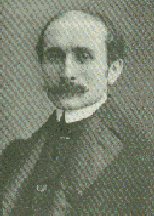 Edmond
Rostand was born in Marseille into a wealthy and cultured Provençal
family. His father was an economist and a poet, a member of the Marseille
Academy and the Institute de France. Rostand studied literature, history,
and philosophy at the Collège Stanislas in Paris. In the 1880s he
published poems and essays in the literary review Mireille. His first play,
LE GANT ROUGE, was produced in 1888. Rostand abandoned his law studies
in 1890 when his first book of poems, LES MUSARDISES, appeared. He gave
it to the poet Rosemonde Gérard, a granddaughter of one of Napoleon's
marshals, whom he married in the same year. Their two sons, Jean and Maurice,
also became writers. Maurice Rostand (1891-1968) published poems, plays
(Le procès d'Oscar Wilde, 1935), and novels. His memoirs, Confession
d'un demi-siècle, appeared in 1948. Jean Rostand was a biologist,
who published essays and manuals and treatises on various aspects of biology.
His satiric portrait, Ignace, ou l'écrivain (1923), was about a
hypersensitive writer, partly based on his father and brother. (see La
Vie et l'œuvre de Jean Rostand by A. Juste, 1971) Edmond
Rostand was born in Marseille into a wealthy and cultured Provençal
family. His father was an economist and a poet, a member of the Marseille
Academy and the Institute de France. Rostand studied literature, history,
and philosophy at the Collège Stanislas in Paris. In the 1880s he
published poems and essays in the literary review Mireille. His first play,
LE GANT ROUGE, was produced in 1888. Rostand abandoned his law studies
in 1890 when his first book of poems, LES MUSARDISES, appeared. He gave
it to the poet Rosemonde Gérard, a granddaughter of one of Napoleon's
marshals, whom he married in the same year. Their two sons, Jean and Maurice,
also became writers. Maurice Rostand (1891-1968) published poems, plays
(Le procès d'Oscar Wilde, 1935), and novels. His memoirs, Confession
d'un demi-siècle, appeared in 1948. Jean Rostand was a biologist,
who published essays and manuals and treatises on various aspects of biology.
His satiric portrait, Ignace, ou l'écrivain (1923), was about a
hypersensitive writer, partly based on his father and brother. (see La
Vie et l'œuvre de Jean Rostand by A. Juste, 1971)
Rostand's first successful
play was LES ROMANESQUES (1894). It was produced at the Comédie
Française and was based on Shakespeare's play Romeo and Juliet.
Three years later produced Cyrano de Bergerac became his most popular and
enduring work - at that time he was 29-year-old. L'AIGLON (1900), a tragedy
based on the life of Napoleon's son, the Duke of Reichstadt, also became
popular. During its first run in 1900, the famous actress Sarah Bernhardt
played the title role. Bernhardt also acted in LA SAMARITAINE (1897), based
on the biblical story, and LA PRINCESSE LOINTAINE (1895), a story about
an unattainable princess and a troubadour hero, who dies in her arms. "The
dream, alone, is of interest. What is life, without a dream." The character
of the hero was based on life of the medieval troubadour Jaufre Rudel.
Le Bargy interpreted Les Romanesques, and Coquelin headed the cast of Cyrano
de Bergerac. With these works Rostand revitalized the old romantic drama
in verse. Naturalism was the major movement in literature - it was the
time of Zola - but Rostand took up old themes and followed the Romantic
tradition of Victor Hugo. When Cyrano was performed, the enthusiasm at
the premiere was unexpected - people wept and it is told that the author
was pelted with ladies' gloves and fans.
Cyrano de Bergerac is poetic,
five-act romantic drama in verse, set in the reign of Louis XIII. The central
character, Cyrano, is a famous swordsman, and an aspiring poet-lover. "A
great nose indicates a great man - / Genial, courteous, intellectual, /
Virile, courageous." Because of his grotesquely large nose "that marches
on / before me by a quarter of an hour," he is convinced that he is too
ugly to deserve his adored Roxane. Cyrano helps his inarticulate rival,
Christian, win her heart by allowing him to present Cyrano's love poems,
speeches, and letters as his own work. Soon the romance starts, Christian
whispers his own love from the shadows in glorious words that Roxane believes
are his. But Christian realizes that it was not his own good looks but
Cyrano's letters that won Roxanne. Before his death on the battlefield,
Christian asks Cyrano to confess their plot to Roxane. Cyrano keeps their
secret for fourteen years. As he is dying years later, he visits Roxane
and reveals her the truth. "That night when 'neath your window Christian
spoke / --Under your balcony, you remember? Well! / There was the allegory
of my whole life: / I, in the shadow, at the ladder's foot, / While others
lightly mount to Love and Fame!" - The play opened at the Porte Saint-Martin
Theater in December 1897. Cyrano's gallantry was seen as the reincarnation
of the true Gallic spirit and Rostand became a national hero.
In 1901, at the age of thirty-three,
Rostand was elected to the Académie Française. However, Rostand
found his fame and unwanted publicity hard to bear. Suffering from poor
health, he retired to his family's country estate at Cambon, in the Basque
county. He continued to write plays and poetry, but his subsequent works
did not gain the popularity of Cyrano de Bergerac. In 1910 appeared CHANTECLER,
a story from the animal world of La Fontaine. It told about a barnyard
rooster who believes that his song makes the sun rise. The work was pronounced
a failure, and the author started his retirement at the luxurious villa
'Arnaga'. Rostand died of pneumonia in Paris on December 2, 1918. His last
dramatic poem was about Don Juan. The posthumously performed play failed
totally.
http://www.kirjasto.sci.fi/rostand.htm
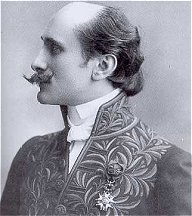 Edmond
Rostand (1868-1918) Known both for his memorable dramatic works
and for patriotic war poems, Edmond Rostand is one of France's great literary
figures. His plays include "La Princesse lointaine" ("The Princess Far
Away"), "La Samaritaine" ("The Woman of Samaria"), "Les Romanesques" ("Romantics"),
"Chantecler" ("Chanticleer"), "L'aignon" ("The Eaglet"), an immediate success,
and the posthumous "La Dernière Nuit de Don Juan" ("The Last Night
of Don Juan"). His best known and most appreciated play is "Cyrano de Bergerac",
published in 1897, which has been translated into practically every language.
He was born on April 1, 1868 and spent his early childhood at the Thedenat
School in Marseilles, an industrial city with colorful crowds, ports, and
ships, which easily aroused his imagination. He was an avid reader, and
he worshipped Walter Scott and Napoleon. His main diversion was a puppet
theater he built at home, for which he built stage props and costumes.
He attended the Marseilles Lycée from 1878 to 1884, during which
time the Third Republic of France was establishing itself under the Constitution
ratified in 1875. He was an outstanding student and showed a deep sensitivity
for literary studies. The most memorable event of his lycée years
was his consecration as "school poet," thanks to a translation into French
verse of Catullus' poem to Lesbia's sparrow. He began publishing his first
poems in 1994 in a small Marseilles magazine called Mireille. He spent
the next two years at the Collège Stanislas in Paris. He was a great
student there and was largely influenced by his professors, especially
René Doumic and Boris de Tamenberg, who introduced him to Shakespeare
and Musset. In addition to his professors, Rostand's family influenced
him profoundly. Eugène, his father, an eminent economist and member
of the Academy of Moral and Political Sciences of Marseilles and of the
Institut de France, was also a poet and translator of Catullus. His uncle,
Alexis, was well known in the music world for his piano compositions, oratorios,
and opera. A taste for music and for rhythmic emotion and color is evident
in Rostand's work. The family member who lent the most to Rostand's warm
temperament was his paternal grandmother, a beautiful and highly sensitive
Spanish woman of Andalusian origin. Rostand inherited his vivacity and
his love for le panache from her. From her, Rostand sought, in his own
words, "the smile by which one excuses oneself for being sublime." After
his secondary studies, Edmond moved to Paris on the Rue de Bourgogne and
began his law studies in order to satisfy his father and professors. After
fulfilling his duties, Edmond made attempts at writing drama. The result
was an unfinished tragedy in verse, "Yorick", as well as two acts in prose,
"Les Petites Manies". Rostand's name became known to the general public,
however, only in 1890, with the publication of his collection of poetry,
"Les Musardises", which he had begun in 1888. Despite a certain fascination
with the daydreams and delightful meanderings of imagination, the critics
gave Rostand no encouragement. "Les Musardises" was not successful. He
married Rosemonde Gérard the same year of "Les Musardises'" publication,
and the work is dedicated to her. She was the daughter of one of Napoleon's
marshals. An orphan, she was raised in a convent. She loved literature
and composed poetry. She was the ideal companion for a poet, and a constant
source of encouragement for him in the face of many failures. Their first
child, Maurice, was born in 1891. That same year, Rostand retired to Cambo,
in the Pyrenees, after being the recipient of the Legion of Honor. But
it was Cyrano de Bergerac, written from April 1896 to January 1897, that
marked Rostand's crowning glory. In 1901, he was elected to the French
Academy. He was timid in society and a feeling of exile persisted in him.
He had also become ill with pulmonary congestion. He felt that what he
was experiencing, namely success and triumph, was the cruelest form of
human anguish. In the midst of this anguish came such works as "Chanticleer"
and the cold tragedy, "The Last Night of Don Juan". His isolation in Cambo
inspired him to add a new concept to his poems: nature. In nature he discovered
a new world and a symbolic life. When France entered the first World War
in 1914, Rostand, certainly unable to fight, began writing vibrant, patriotic
poems, even visiting the trenches in order to see first hand the destruction,
blood, and suffering. The horrors of war had a profound impact on his physical
and mental health. On December 22, 1918, six weeks after the armistice
ending the war, Rostand died. Edmond
Rostand (1868-1918) Known both for his memorable dramatic works
and for patriotic war poems, Edmond Rostand is one of France's great literary
figures. His plays include "La Princesse lointaine" ("The Princess Far
Away"), "La Samaritaine" ("The Woman of Samaria"), "Les Romanesques" ("Romantics"),
"Chantecler" ("Chanticleer"), "L'aignon" ("The Eaglet"), an immediate success,
and the posthumous "La Dernière Nuit de Don Juan" ("The Last Night
of Don Juan"). His best known and most appreciated play is "Cyrano de Bergerac",
published in 1897, which has been translated into practically every language.
He was born on April 1, 1868 and spent his early childhood at the Thedenat
School in Marseilles, an industrial city with colorful crowds, ports, and
ships, which easily aroused his imagination. He was an avid reader, and
he worshipped Walter Scott and Napoleon. His main diversion was a puppet
theater he built at home, for which he built stage props and costumes.
He attended the Marseilles Lycée from 1878 to 1884, during which
time the Third Republic of France was establishing itself under the Constitution
ratified in 1875. He was an outstanding student and showed a deep sensitivity
for literary studies. The most memorable event of his lycée years
was his consecration as "school poet," thanks to a translation into French
verse of Catullus' poem to Lesbia's sparrow. He began publishing his first
poems in 1994 in a small Marseilles magazine called Mireille. He spent
the next two years at the Collège Stanislas in Paris. He was a great
student there and was largely influenced by his professors, especially
René Doumic and Boris de Tamenberg, who introduced him to Shakespeare
and Musset. In addition to his professors, Rostand's family influenced
him profoundly. Eugène, his father, an eminent economist and member
of the Academy of Moral and Political Sciences of Marseilles and of the
Institut de France, was also a poet and translator of Catullus. His uncle,
Alexis, was well known in the music world for his piano compositions, oratorios,
and opera. A taste for music and for rhythmic emotion and color is evident
in Rostand's work. The family member who lent the most to Rostand's warm
temperament was his paternal grandmother, a beautiful and highly sensitive
Spanish woman of Andalusian origin. Rostand inherited his vivacity and
his love for le panache from her. From her, Rostand sought, in his own
words, "the smile by which one excuses oneself for being sublime." After
his secondary studies, Edmond moved to Paris on the Rue de Bourgogne and
began his law studies in order to satisfy his father and professors. After
fulfilling his duties, Edmond made attempts at writing drama. The result
was an unfinished tragedy in verse, "Yorick", as well as two acts in prose,
"Les Petites Manies". Rostand's name became known to the general public,
however, only in 1890, with the publication of his collection of poetry,
"Les Musardises", which he had begun in 1888. Despite a certain fascination
with the daydreams and delightful meanderings of imagination, the critics
gave Rostand no encouragement. "Les Musardises" was not successful. He
married Rosemonde Gérard the same year of "Les Musardises'" publication,
and the work is dedicated to her. She was the daughter of one of Napoleon's
marshals. An orphan, she was raised in a convent. She loved literature
and composed poetry. She was the ideal companion for a poet, and a constant
source of encouragement for him in the face of many failures. Their first
child, Maurice, was born in 1891. That same year, Rostand retired to Cambo,
in the Pyrenees, after being the recipient of the Legion of Honor. But
it was Cyrano de Bergerac, written from April 1896 to January 1897, that
marked Rostand's crowning glory. In 1901, he was elected to the French
Academy. He was timid in society and a feeling of exile persisted in him.
He had also become ill with pulmonary congestion. He felt that what he
was experiencing, namely success and triumph, was the cruelest form of
human anguish. In the midst of this anguish came such works as "Chanticleer"
and the cold tragedy, "The Last Night of Don Juan". His isolation in Cambo
inspired him to add a new concept to his poems: nature. In nature he discovered
a new world and a symbolic life. When France entered the first World War
in 1914, Rostand, certainly unable to fight, began writing vibrant, patriotic
poems, even visiting the trenches in order to see first hand the destruction,
blood, and suffering. The horrors of war had a profound impact on his physical
and mental health. On December 22, 1918, six weeks after the armistice
ending the war, Rostand died.
ROSTAND,
GREAT FRENCH POET, DEAD: An obituary
This obituary was originally
published in Theatre Magazine, Vol. 29, No. 1. Willis Steell. New York:
Theatre Magazine Company, 1919. p. 12.
WHEN Edmond Rostand, the
distinguished dramatic poet who died of pneumonia on December 2nd (1918),
quitted Paris after his first world-renowned success, Cyrano de Bergerac,
he gave out not the true reason for his exile to a magnificant estate in
the Pyrenees, conditions of his health, but said explicitly that he was
leaving the Capital of Art in order to get out of the reach of important
interviewers, lionizers, et al.
In other words he took a
leaf from the book of the English Tennyson and intended to cultivate his
talents in seclusion. There is all the difference of nationality, however,
in the way the Englishman carried out his scheme of a cloistered life and
the way the Frenchman did. At Cambo, if one ever got so far, there was
always a welcome from Rostand who seemed, indeed, to be glad of an excuse
to break his literary rule and become a delightful host. Americans who
traveled thither were never turned away and often when they went to see
Rostand as a mere passing traveler they ended by the poet's warm invitation
by becoming for as long as they could stay the poet's guests.
Eccentric as the great French
poet must have been, for everybody in Paris thus describes him, his eccentricity
was purely Gallic. He wearied of his own society quickly and like a later
Montaigne he went up to his ivory tower not to compose anything but himself--in
slumber. A real French hermit is an inconceivable human and Rostand was
not a hermit in any foreign sense.
He loved the sound of cities
and only delicate health took him out of it. Because of his predilection
for crowds, his dramatis personae became the longest in modern times. The
very basse cour had to be a thickly settled domain to attract him. Thus
he filled a scene with cock and hen, pheasant and all the denizens of the
farm yard when he set about the play which in the opinion of his countrymen
gives him the surest claim to immortality Chanticler.
The poet began his magnum
opus shortly after he had arrived at Cambo and made the acquaintance of
his feathered friends. But he was seven years writing it and re-writing
it and long before it reached a public, many of the circumstances attending
its composition and production had won for him the reputation which he
did not justly merit, that of an unreasonable eccentric. By its unwritten
history, if by nothing else, the piece won him fame and money. The very
rumor of it blew for the author a glorious bubble of reputation.
Younger than Balzac when
he died, Rostand in his life and habit of work seemed the antithesis of
the famous novelist. Work killed the one and rest the other, unless the
seeds of disease were in the poet as he always said and probably believed.
Born in Marseilles, he displayed little of the meridional Frenchman in
his career but indeed his career is without precedent in the literature
of France. Almost from the beginning his talents were recognized and at
twenty-nine when he produced Cyrano de Bergerac his fortune was made.
That play came as a reaction.
Pieces in verse are not uncommon in France where they are accorded a respectful
hearing but no reward, and the dramatists when Rostand began as an author
were frankly matter of fact and mercenary. Who would have dreamed that
a five act drama in verse with a hero whom only littérateurs remembered,
composed by a writer literally unknown (except to a circle of high brows
and Sarah Bernhardt) would shove him at the age of twenty-nine into the
close circle of the Immortals? But Cyrano de Bergerac is more than a poetic
arrangement of a drama. It is drama understandable and to be understood
at once by the public. He had not written one or two failures, including
La Samaritaine, without learning the playwright's trade. He had learned
it thoroughly and meant to avoid by immense technique the pitfall of the
study drama. Cyrano is delightful reading but it is meant for the stage.
Only a few years had passed
since his first essay had failed at the Cluny. It must have been a complete
failure for no enterprising manager in the encouragement of later triumphs
has dared to put on Le Gant Rouge with a hope to score by these. Only a
few years, as lives go, even in high literature, passed before the success
of L'Aiglon dotted the "I" and crossed the "T" of Cyrano. Then came a long
rest, a quiet study of barn yard life which produced Chanticler. The victory
of the much-heralded piece surprised even Rostand idolaters; the French
pronounce it the high mark of their intellectual history. It has never
had an adequate representation in an English version although several excellent
translations exist. Whether or not with an English speaking company comparable
to that which Rostand himself demanded for his play in France, it would
win from us the same applause as at home may be doubted. For Chanticler
is a sort of French idiom, not to be easily acquired by other races.
WILLIS STEELL
20
Ways to Insult a Nose
|

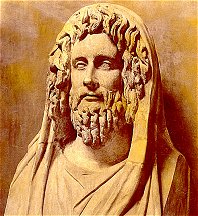
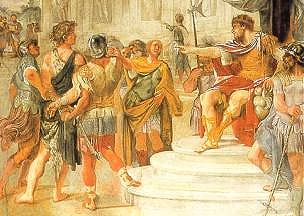 NUMA
POMPILIUS, second legendary king oi Rome (7 15 672 B.c.), was a Sabine,
a native of Cures, and his wife was the daughter of Titus Tat4us, the Sabine
colleague of Romulus. He was elected by the Roman people at the close of
a years interregnum, during which the sovereignty had been exercised by
the members of the senatein rotation. Nearly all the early religious institutions
of Rome were attributed to him. He set up the worhip of Terminus (the god
of landmarks), appointed the festival of Fides (Faith), built the temple
of Janus, reorganized the calendar and fixed days of business and holiday.
He instituted the flamens (sacred priests) of Jupiter, Mars and Quirinus;
the virgins of Vesta, to keep the sacred fire burning on the hearth of
the city; the Salii, to guard the shield that fell from heaven; the pontifices
and augurs, to arrange the rites and interpret the will of the gods; he
also divided the handicraftsmen into nine gilds. He derived his inspiration
from his wife, the nymph Egeria, whom he used to meet by night in her sacred
grove. After a long and peaceful reign, during which the gates of Janus
were closed, Numa died and was succeeded by the warlike Tullus Hostilius.
Livy (xl. 29) tells a curious story of two stone chests, bearing inscriptions
in Greek and Latin, which were found at the foot of the Janiculum (181
B.C.), one purporting to contain the body of Numa and the other his books.
The first when opened was found to be empty, but the second contained fourteen
books relating to philosophy and pontifical law, which were publicly burned
as tending to undermine the established religion. No single legislator
can really be considered responsible for all the institutions ascribed
to Numa; they are essentially Italian, and older than Rome itself. Even
Roman tradition itself wavers; e.g. the fetiales are variously attributed
to Tullus Hostiius and Ancus Marcius. The supposed law-books, which were
to all appearance new when discovered, were clearly forgeries.
NUMA
POMPILIUS, second legendary king oi Rome (7 15 672 B.c.), was a Sabine,
a native of Cures, and his wife was the daughter of Titus Tat4us, the Sabine
colleague of Romulus. He was elected by the Roman people at the close of
a years interregnum, during which the sovereignty had been exercised by
the members of the senatein rotation. Nearly all the early religious institutions
of Rome were attributed to him. He set up the worhip of Terminus (the god
of landmarks), appointed the festival of Fides (Faith), built the temple
of Janus, reorganized the calendar and fixed days of business and holiday.
He instituted the flamens (sacred priests) of Jupiter, Mars and Quirinus;
the virgins of Vesta, to keep the sacred fire burning on the hearth of
the city; the Salii, to guard the shield that fell from heaven; the pontifices
and augurs, to arrange the rites and interpret the will of the gods; he
also divided the handicraftsmen into nine gilds. He derived his inspiration
from his wife, the nymph Egeria, whom he used to meet by night in her sacred
grove. After a long and peaceful reign, during which the gates of Janus
were closed, Numa died and was succeeded by the warlike Tullus Hostilius.
Livy (xl. 29) tells a curious story of two stone chests, bearing inscriptions
in Greek and Latin, which were found at the foot of the Janiculum (181
B.C.), one purporting to contain the body of Numa and the other his books.
The first when opened was found to be empty, but the second contained fourteen
books relating to philosophy and pontifical law, which were publicly burned
as tending to undermine the established religion. No single legislator
can really be considered responsible for all the institutions ascribed
to Numa; they are essentially Italian, and older than Rome itself. Even
Roman tradition itself wavers; e.g. the fetiales are variously attributed
to Tullus Hostiius and Ancus Marcius. The supposed law-books, which were
to all appearance new when discovered, were clearly forgeries.
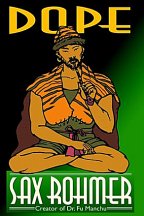
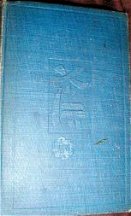
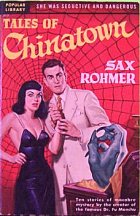
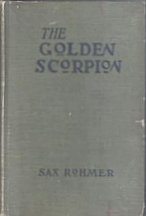
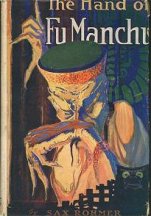
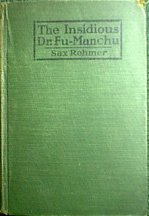
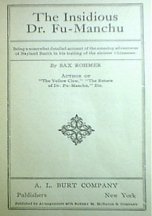
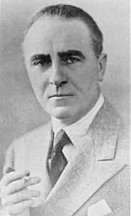
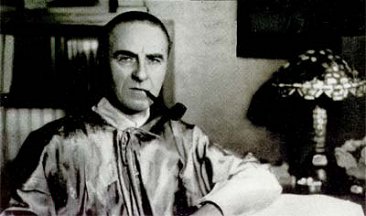
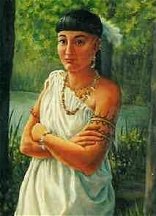
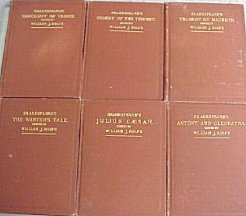
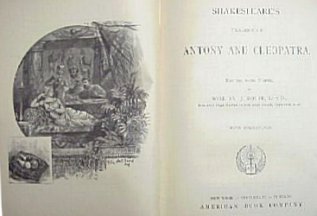
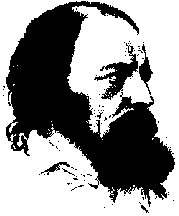
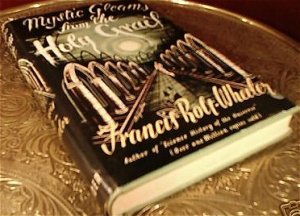
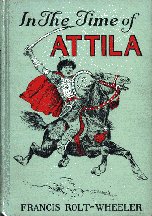
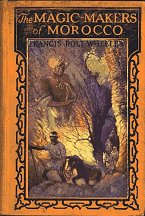
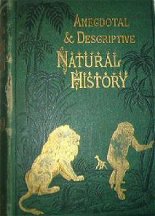 Part One:
Animals with 184 pages: Contents include: Ch. I: Introduction ~
Ch. II: The elephant.~ Ch. III: The Rhinoceros ~ Ch. IV: The Lion.~ Ch.
V: The Puma, or American Lion.~ Ch. VI: The Tiger.~ Ch. VII: The Leopard
and Panther, The Cheetah or Hunting Leopard, The Ounce, The Jaguar, The
Ocelot. Ch. VIII; The Hyena, The Proteles, The Jackal, the zebra, the quagga.-
IX, the ruminantia, the camel, the dromedary, the llama, the guanaco, the
giraffe.- chap X, the quadrumana, the chimpanzee, the orang outan, the
gorilla.- chap XI, the gibbons, the siamang, the agile gibbon, the
ateles, the quata or coaita, the baboons, the common baboon, the chacma,
the mandrill, the drill. chap XII, the buffalo, the yak, the bison, the
musk ox.- chap XIII, the marsupialia, the kangaroo.- chap XIV, the bear,
the brown bear, the black bear, the grisly bear, the polar bear, the malayan
sun bear, the sloth bear, the apectacled bear.- chap XV, the wolf, the
common fox, the american red fox, the tri coloured fox, the balck or silver
fox.- chap XVI, the reindeer, the elk, the gnu, the nylghau, the ibex,
the gems bok, the chamois, the gazelle. ~184 pages
Part One:
Animals with 184 pages: Contents include: Ch. I: Introduction ~
Ch. II: The elephant.~ Ch. III: The Rhinoceros ~ Ch. IV: The Lion.~ Ch.
V: The Puma, or American Lion.~ Ch. VI: The Tiger.~ Ch. VII: The Leopard
and Panther, The Cheetah or Hunting Leopard, The Ounce, The Jaguar, The
Ocelot. Ch. VIII; The Hyena, The Proteles, The Jackal, the zebra, the quagga.-
IX, the ruminantia, the camel, the dromedary, the llama, the guanaco, the
giraffe.- chap X, the quadrumana, the chimpanzee, the orang outan, the
gorilla.- chap XI, the gibbons, the siamang, the agile gibbon, the
ateles, the quata or coaita, the baboons, the common baboon, the chacma,
the mandrill, the drill. chap XII, the buffalo, the yak, the bison, the
musk ox.- chap XIII, the marsupialia, the kangaroo.- chap XIV, the bear,
the brown bear, the black bear, the grisly bear, the polar bear, the malayan
sun bear, the sloth bear, the apectacled bear.- chap XV, the wolf, the
common fox, the american red fox, the tri coloured fox, the balck or silver
fox.- chap XVI, the reindeer, the elk, the gnu, the nylghau, the ibex,
the gems bok, the chamois, the gazelle. ~184 pages
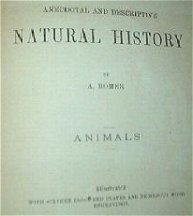 Part Two:
Aquatic, Domestic and Minor Animals. with184 pages: Chap I, Aquatic
Animals.- chap II, the hippopotamus.- chap III, the walrus.- chap IV, the
seal, the common seal, the marbled seal, the greenland seal, the elephant
seal.- chap V, the beaver.- chapVI, the otter, the water rat, or vole,
the russian musk rat.- chap VII, the orinthorhynchus.- chap VIII, the dog.-
chap IX, the horse.- chap X, the ox.- chap XI, the sheep, the goat, the
cashmere goat, the wild boar, the hog, the babiroussa, the white lipped
peccary, the american tapir.- chap XII, the wild cat, the domestic cat,
the civet, the ichneumon, the polecat, the ferret, the weasel, the beech
marten, the pine marten, the sable, the stoat, or ermine, the skunk, the
racoon, the jerboa.- chap XIII, the hare, the rabbit, the squirrel, the
badger, the hedgehog, bats.- chap XIV, the aye aye, the sloth, the porcupine,
the blutton, the great ant eater, the armadillo, the opossum.- chap XV,
the wombat, the ashy koala, the echidna.
Part Two:
Aquatic, Domestic and Minor Animals. with184 pages: Chap I, Aquatic
Animals.- chap II, the hippopotamus.- chap III, the walrus.- chap IV, the
seal, the common seal, the marbled seal, the greenland seal, the elephant
seal.- chap V, the beaver.- chapVI, the otter, the water rat, or vole,
the russian musk rat.- chap VII, the orinthorhynchus.- chap VIII, the dog.-
chap IX, the horse.- chap X, the ox.- chap XI, the sheep, the goat, the
cashmere goat, the wild boar, the hog, the babiroussa, the white lipped
peccary, the american tapir.- chap XII, the wild cat, the domestic cat,
the civet, the ichneumon, the polecat, the ferret, the weasel, the beech
marten, the pine marten, the sable, the stoat, or ermine, the skunk, the
racoon, the jerboa.- chap XIII, the hare, the rabbit, the squirrel, the
badger, the hedgehog, bats.- chap XIV, the aye aye, the sloth, the porcupine,
the blutton, the great ant eater, the armadillo, the opossum.- chap XV,
the wombat, the ashy koala, the echidna.
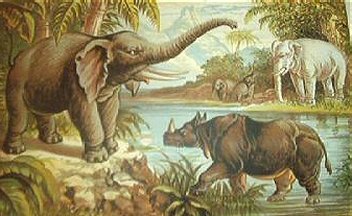
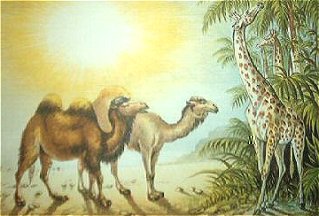
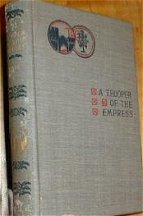





 Edmond
Rostand was born in Marseille into a wealthy and cultured Provençal
family. His father was an economist and a poet, a member of the Marseille
Academy and the Institute de France. Rostand studied literature, history,
and philosophy at the Collège Stanislas in Paris. In the 1880s he
published poems and essays in the literary review Mireille. His first play,
LE GANT ROUGE, was produced in 1888. Rostand abandoned his law studies
in 1890 when his first book of poems, LES MUSARDISES, appeared. He gave
it to the poet Rosemonde Gérard, a granddaughter of one of Napoleon's
marshals, whom he married in the same year. Their two sons, Jean and Maurice,
also became writers. Maurice Rostand (1891-1968) published poems, plays
(Le procès d'Oscar Wilde, 1935), and novels. His memoirs, Confession
d'un demi-siècle, appeared in 1948. Jean Rostand was a biologist,
who published essays and manuals and treatises on various aspects of biology.
His satiric portrait, Ignace, ou l'écrivain (1923), was about a
hypersensitive writer, partly based on his father and brother. (see La
Vie et l'œuvre de Jean Rostand by A. Juste, 1971)
Edmond
Rostand was born in Marseille into a wealthy and cultured Provençal
family. His father was an economist and a poet, a member of the Marseille
Academy and the Institute de France. Rostand studied literature, history,
and philosophy at the Collège Stanislas in Paris. In the 1880s he
published poems and essays in the literary review Mireille. His first play,
LE GANT ROUGE, was produced in 1888. Rostand abandoned his law studies
in 1890 when his first book of poems, LES MUSARDISES, appeared. He gave
it to the poet Rosemonde Gérard, a granddaughter of one of Napoleon's
marshals, whom he married in the same year. Their two sons, Jean and Maurice,
also became writers. Maurice Rostand (1891-1968) published poems, plays
(Le procès d'Oscar Wilde, 1935), and novels. His memoirs, Confession
d'un demi-siècle, appeared in 1948. Jean Rostand was a biologist,
who published essays and manuals and treatises on various aspects of biology.
His satiric portrait, Ignace, ou l'écrivain (1923), was about a
hypersensitive writer, partly based on his father and brother. (see La
Vie et l'œuvre de Jean Rostand by A. Juste, 1971)

